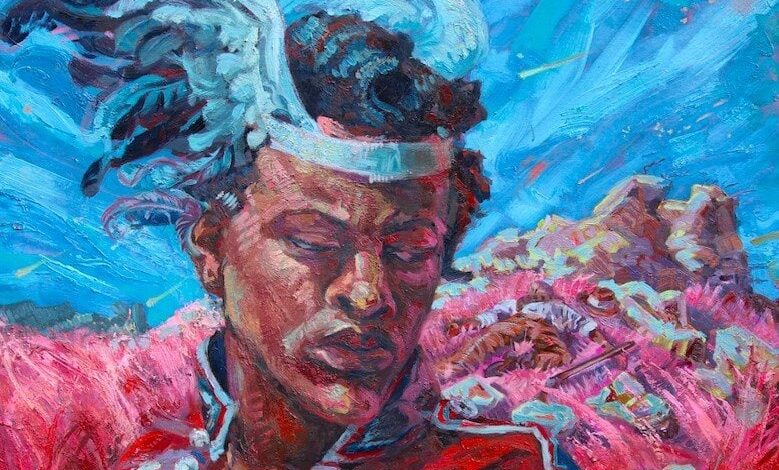Athi-Patra Ruga Will Open His Solo Exhibition ‘Amadoda On The Verge…[1835-2025]’ At BKhz Gallery

Athi-Patra Ruga Will Open His Solo Exhibition ‘Amadoda On The Verge…[1835-2025]’ At BKhz Gallery. Athi-Patra Ruga will open his solo exhibition ‘Amadoda on the Verge…[1835-2025]’ at BKhz Gallery, in Rosebank, Johannesburg on Saturday, 31 August 2024.
“In this new body of luscious and layered paintings, I welcome you to a part-speculative, part-historical frontier in which complex notions of collaboration and conflict between settler and native, colonizer and colonized are reflected in the sartorial choices of my avatars. The decay and ruin of the memorials and military forts in my native Eastern Cape has drawn my attention to a lapse in our collective memory. It has awakened my need to revisit the geography of the South African colonial frontier and explore the military fort as a microcosm of frontier encounters. The Eastern Cape, which was a fiercely contested battleground, indicates a significant collective loss and has prompted me to offer up a counter-narrative to eulogize that which has been overlooked and omitted,” explains Athi-Patra Ruga.
Continuing with myth-making as a contemporary response to colonial history, Ruga has created a series of avatars that probe the continued influence of historical tropes on performativity, agency, and representations of black masculinities. The lone avatars of Ruga’s Frontier are on the verge of something curious or uncharted; he is fascinated with the uneasiness of the frontier both as a physical and psychological limit and a threshold of new opportunities and experiences.
Inspired by diverse historical flash points like the Crimean War, the messianic prophecies of Ntsikana and Mangconde, sightings of Haley’s Comet, and the publication of Frankenstein, Ruga draws on the neo-gothic sensibility prevalent in the architecture and literature of the frontier period and the somber atmosphere of the contemporary Eastern Cape.
“The dark history of settler occupation and religious domination has inspired me to focus on the continued effects of disembodiment on the black male body.Using costume and craftsmanship, I want to create a remedy, an alternative to a history of loss and disassociation.
“In the painting Dyani Mfengu on the Kei River [1835], I have painted a young man who is part of the Mfengu Levy. The Mfengu were a group of 17000 black pioneers who crossed the Nciba [Kei] River, allied with the British against the Xhosa, and who swore allegiance to the British Crown. They were instrumental in winning several decisive victories for the British.”
“The term impambano, meaning a schism between the body, mind, and spirit, is referenced allegorically in the character’s combination of attire. This mpambano, the clash of British, Boer, and Xhosa is referenced in clothes salvaged from the battlefield. In the painting, I have suggested a split between the known and the unknown. The assailant is deliberately split from the frame as I reconcile my personal history,” adds Athi-Patra Ruga.
As a virtuoso in multiple disciplines, Ruga’s use of oil paint on canvas is a conceptual choice. It positions his work within the long tradition of history painting and is in dialogue with the chosen medium of colonial reportage by influential 18th-century painters such as Frederick I’ons and Thomas Baines. Contemporary scholars acknowledge the often biased nature of these depictions, which were both reportage and propaganda used to justify European expansion into ’empty land’ as well as to depict native populations as savage and to justify the ‘civilizing’ Christian mission.
In his work, Ruga posits a counter-narrative that re-centers the black sitter and the complexity of these colonial encounters. Like oil on canvas, Ruga’s choice of stained glass also intentionally draws on the historical gravitas of the medium. Traditionally used to lionize Western religion and the nobility, Ruga appropriates the glass to ‘elevate’ his subjects but simultaneously draws attention to constructed notions of legitimacy.
Ruga employs his characters as a lens to re-examine the fraught history of a colonial past, and its continued impact on the present and to propose a possible humanist future.



